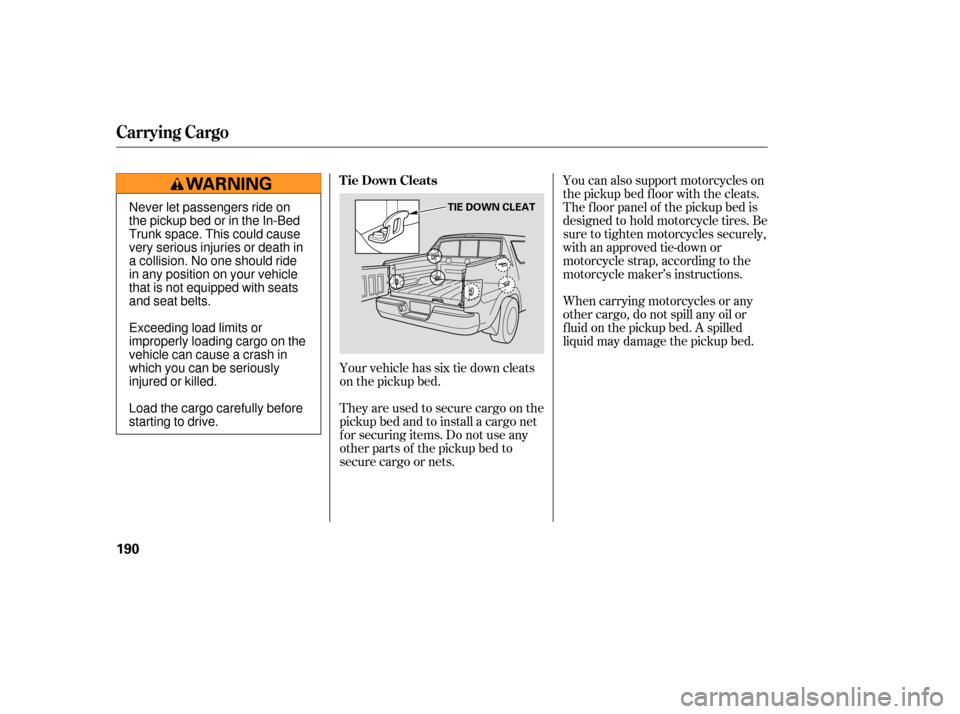Page 67 of 331

This indicator has two functions:
This indicator also blinks several
times when you turn the ignition
switch from the ON (II) position to
the ACCESSORY (I) or LOCK (0)
position.
If it stays on after you have fully
released the parking brake while
the engine is running, or if it
comes on while driving, there
could be a problem with the brake
system. For more information, see
page . This indicator normally comes on for
a few seconds when you turn the
ignition switch to the ON (II)
position, and when the ignition
switch is turned to the START (III)
position. If it comes on at any other
time, there is a problem with the
ABS. If this happens, have your
ve
hicle checked at a dealer. With the
indicator on, your vehicle still has
norm al braking ability but no anti-
lock brakes. For more info rmation,
see page . This indicator comes on for a few
seconds wh
en you turn the ignition
switch to the ON (II) position. It will
gooffifyouhaveinserteda
properly-coded ignition key. If it is
not a properly-coded key, the
indicator will blink and the engine
will not start (see page ).
Itcomesonwhenyouturnthe
ignition switch to the ON (II)
position. It is a reminder to check
the parking brake. A beeper
sounds if you drive with the
parking b
rake not fully released.
Driving with the parking brake not
fully released can damage the
brakes and tires.
1.
2. 81
290 208
Anti-lock Brake System
(A BS) Indicator
Immobilizer System
Indicator
Parking Brake
and Brake
System
Indicator
Instrument Panel Indicators
Inst rument s and Cont rols
63
U.S. Canada
Page 72 of 331

This indicator normally comes on for
a few seconds when you turn the
ignition switch to the ON (II)
position. If it comes on while driving, This
indicator normally comes on for
a few seconds when you turn the
ignition switch to the ON (II)
position.
it indicates that one or more of your
vehicl e’s tires are extremely low on
pressure.
If this happens, pull to the side of the
ro ad when it is safe, check which tire
has lost the pressure on the tire
pressure monitor, and determine the
cause. If it is because of a flat tire,
replace the flat tire with the compact
spare (see page ), and have the
flat tire repaired as soon as possible.
If two or more tires are underinflated,
call a professional towing service
(see page ). Refer to page
f or more inf ormation. If this indicator comes on and stays
on at any other time, or if it does not
come on when you turn the ignition
switch to the ON (II) position, there
is a problem with the TPMS. With
this indicator on, the low tire
pressure indicator and the tire
pressure monitor will not come on
when a tire loses pressure. Take the
vehicle to your dealer to have the
system checked.
This monitor normally comes on f or
a f ew seconds when you turn the
ignition switch to the ON (II)
position. While driving, the
appropriate tire indicator will come
on, along with the low tire pressure
indicator, if a tire is extremely
underinf lated or has suddenly lost
pressure. See
forwhattodoif this
indicator comes on.
274
296
204 Tire Pressure Monitoring
System (T PMS) Indicator
Low Tire Pressure
Indicator T ire Pressure Monitor
Low Tire Pressure
Indicator
Instrument Panel Indicators
68
Page 179 of 331

�µ
Each tire, including the spare (if
provided), should be checked
monthly when cold and inf lated to
the inf lation pressure recommended
by the vehicle manuf acturer on the
vehicle placard or tire inf lation
pressure label.
(If your vehicle has tires of a
dif f erent size than the size indicated
on the vehicle placard or tire
inf lation pressure label, you should
determine the proper tire inf lation
pressure f or those tires.)As an added safety feature, your
vehicle has been equipped with a tire
pressure monitoring system (TPMS)
that illuminates a low tire pressure
telltale
and
when one or more of your tires is
signif icantly under-inf lated.
Accordingly, when the low tire
pressure telltale illuminates, you
should stop and check your tires as
soon as possible, and inf late them to
the proper pressure. Driving on a signif icantly under-
inf lated tire causes the tire to
overheat and can lead to tire failure.
Under-inf lation also reduces f uel
efficiency and tire tread life, and may
af f ect the vehicle’s handling and
stopping ability.
Please note that the TPMS is not a
substitute for proper tire
maintenance, and it is the driver’s
responsibility to maintain correct tire
pressure, even if under-inf lation has
not reached the level to trigger
illumination of the TPMS low tire
pressure telltale.
CONT INUED
Tire Pressure Monitoring System (TPMS) Required Federal Explanation
Features
175
Page 180 of 331
�µ
Always check the TPMS malf unction
telltale af ter replacing one or more
tires or wheels on your vehicle to
ensure that the replacement or
alternate tires and wheels allow the
TPMS to continue to f unction
properly.
Your vehicle has also been equipped
with a TPMS malf unction indicator
to indicate when the system is not
operating properly. The TPMS
malf unction indicator is provided by
a separate telltale, which displays the
symbol ‘‘TPMS’’ when illuminated.
When the malf unction indicator is
illuminated,
the system may not be able to detect
or signal low tire pressure as
intended.
TPMS malf unctions may occur f or a
variety of reasons, including the
installation of replacement or
alternate tires or wheels on the
vehicle that prevent the TPMS f rom
f unctioning properly.
Tire Pressure Monitoring System (TPMS) Required Federal Explanation
176
Page 189 of 331

Larger or smaller wheels and tires
can interf ere with the operation of
your vehicle’s anti-lock brakes and
other systems.
Modif ying your steering wheel or
any other part of your vehicle’s
saf ety systems could make the
systems inef f ective.
If you plan to modif y your vehicle,
consult your dealer.
Removing parts f rom your vehicle,
or replacing components with
non-Honda components could
seriously af f ect your vehicle’s
handling, stability, and reliability.
Some examples are:
Lowering the vehicle with a non-
Honda suspension kit that
signif icantly reduces ground
clearance can allow the
undercarriage to hit speed bumps
or other raised objects, which
could cause the airbags to deploy.
Raising your vehicle with a
non-Honda suspension kit can
af f ect the handling and stability.
Non-Honda wheels, because they
are a universal design, can cause
excessive stress on suspension
components and will not be
compatible with the tire pressure
monitoring system.
Bef ore installing any electronic
accessory, have the installer
contact your dealer f or assistance.
If possible, have your dealer
inspect the f inal installation.
Do not install accessories on the
side pillars or across the rear
windows. In these areas,
accessories may interf ere with
proper operation of the side
curtain airbags.
A ccessories and Modif ications
Modif ying Your Vehicle
Bef ore Driving
185
Page 190 of 331
The pickup bed on your vehicle
allows you to carry heavy and large
cargo. You can also store items in
theIn-BedTrunkandonaroof-rack
(if equipped).
Your vehicle also has these
convenient storage areas inside:Glove box
Front door and seat-back pockets
Fold-up rear seat with under-seat
storage
Console compartment
Pockets on the dashboard
However, carrying too much cargo,
or improperly storing it, can af f ect
your vehicle’s handling, stability,
stopping distance, and tires, and
make it unsaf e. Bef ore carrying any
type of cargo, be sure to read the
f ollowing pages.
Carrying Cargo
186
GLOVE BOX
DASHBOARD
POCKETS
PICKUP BED
CONSOLE
COMPARTMENTS
SEAT-BACK POCKETS
FOLD-UP REAR SEAT WITH UNDER-SEAT STORAGE IN-BED TRUNK
DOOR POCKET
Page 194 of 331

Your vehicle has six tie down cleats
on the pickup bed.You can also support motorcycles on
the pickup bed floor with the cleats.
The f loor panel of the pickup bed is
designed to hold motorcycle tires. Be
sure to tighten motorcycles securely,
with an approved tie-down or
motorcycle strap, according to the
motorcycle maker’s instructions.
They are used to secure cargo on the
pickup bed and to install a cargo net
f or securing items. Do not use any
other parts of the pickup bed to
secure cargo or nets. When carrying motorcycles or any
other cargo, do not spill any oil or
f luid on the pickup bed. A spilled
liquid may damage the pickup bed.
Carrying Cargo
Tie Down Cleats
190
TIE DOWN CLEATNever let passengers ride on
the pickup bed or in the In-Bed
Trunk space. This could cause
very serious injuries or death in
a collision. No one should ride
in any position on your vehicle
that is not equipped with seats
and seat belts.
Exceeding load limits or
improperly loading cargo on the
vehicle can cause a crash in
which you can be seriously
injured or killed.
Load the cargo carefully before
starting to drive.
Page 199 of 331

Youshoulddothefollowingchecks
and adjustmen ts before you drive
your vehicle.
Make sure all windows, mirrors,
and outside lights are clean and
unobstructed. Remove frost, snow,
or ice.
Check that the hood is fully closed.
Check that the tailgate is fully
closed when it is not used as an
exte nded pickup bed.
Vi sually check the tires. If a tire
looks low, use a gauge to check its
pressure.
Check that any items you may be
carrying are stored properly or
fastened down securely. Check
the adjustment of the
inside and outside mirrors (see
page ).
Check the steering wheel
ad justment (see page ).
Make sure the doors and In-Bed
Trunk are securely closed and
locked.
Fasten your seat belt. Check that
your passengers have fastened
their seat belts (see page ).
Wh en you start the engine, check
the gauges and indicato rs in the
instrument panel (see page ).
Check the seat adjustment (see
pages and ).
1.
2.
3.
4.
5.
6.
8. 7.
9.
10.
11. 14
110
79
59
98 100
Preparing to Drive
Driving
195